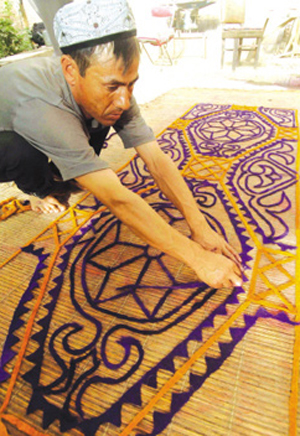According to records, one origin of the Uygur’s ancestors were nomadic herdsmen. In 108 BC (Emperor Wu of Han Dynasty), Princess Xijun, a princess of the Han Dynasty, married the king of Wusun Kingdom in the ancient Western Regions and lived in the present Ili grassland for three years. She wrote a poem which depicted the life of nomadic tribes, called—“ Lived in yurts of felt.” Moreover, Li Duan, a poet of the Tang Dynasty, also mentioned the felt-making among nomadic peoples or settled tribesmen in his poem. Therefore, making flower felts was quite prevalent in northwest China at that time.
 |
Traditionally, Uygur people sleep on the adobe Kang (a platform in the room) and the wool felts are their first choice to make the bed because flower felts have the quality of softness, damp-proofing and heat-preservation. What is more, thanks to their inexpensive prices, even the poorest can afford them. In the past, there was no sheet on the Kang, and the felts would be open to eyes after making the bed. Uygur people are beauty lovers, and it is a custom that every room in the house should be carefully decorated; wool felt is one of traditional handicrafts for house decoration. Thus, making flower felt gradually developed as an important handicraft.
The major subsistence of the Uygurs is farming, but raising sheep, cattle and camels is an important part of their means of living, and every household stores wool for making felts. They make it themselves or invite skilful craftsmen to help them. Firstly, they spread the straw mat on the ground of the yard, fluff the wool with a willow branch, wet the wool, then roll up the mat while pressing it, and lastly dry it. A new felt is done. However, making flower felt needs craftsmen because they have their ways to design and dye the felt in the process of making, which demands more skilful hands.
There are four styles of techniques in making Uygur flower felt: first, designing the colored wool into different patterns before pressing it; second, laying a thin inlaid flower felt on the wool felt;. third, printing patterns on the wool felt; and forth, drawing pictures with a brush pen and embroidering color cloth on the felt. Generally there are eight patterns of Uyghur felts: (1) with pictures of plants, such as arum lily, willow branches, chrysanthemum, pomegranate flower, oleander, honeysuckle, and cockscomb; (2) with figures of animals, such as sheep’s horn, swallow’s tail, horse hoop, camel’s paw, and dog’s paw; (3) with patterns of daily utensils, such as the wheel, rope, kettle, comb and wooden rake; (4) with patterns of buildings or parts of buildings, such as steps, panes, parapets, niches, shrines, and domes; (5) with some religious symbols such as “ ???. (It is because Uygurs used to believe in Shamanism, Buddhism, and Nestorianism in their history); (6) with pictures of natural objects, such as an eddy, the moon, the stars, light, and a water wave; (7) with patterns borrowed from Han people; and (8) with geometrical figures. The flower felts are made in different sizes according to the needs. In some special cases, exquisite flower felts would replace tapestry to decorate the wall in Uyghur houses.
You may also like: